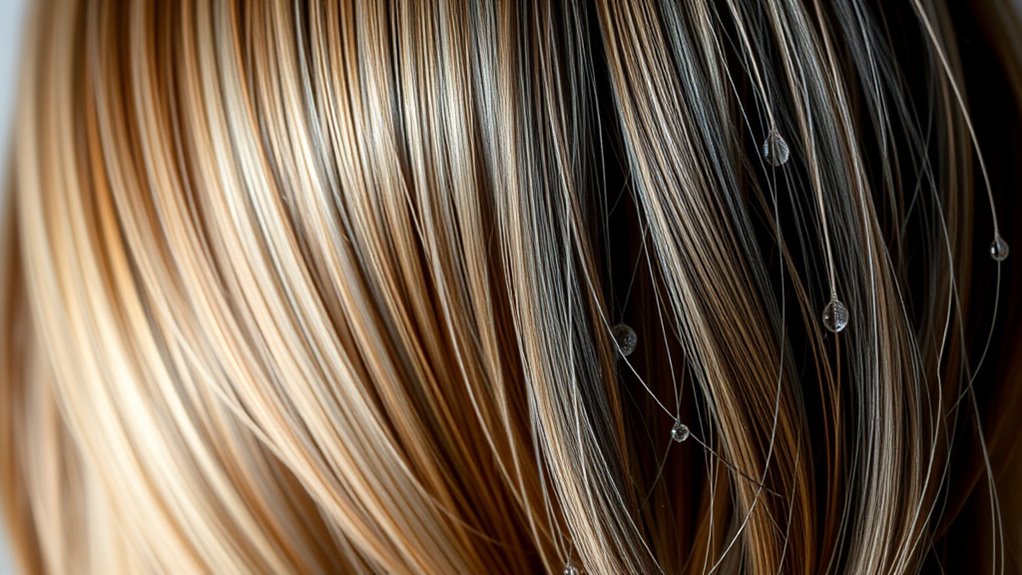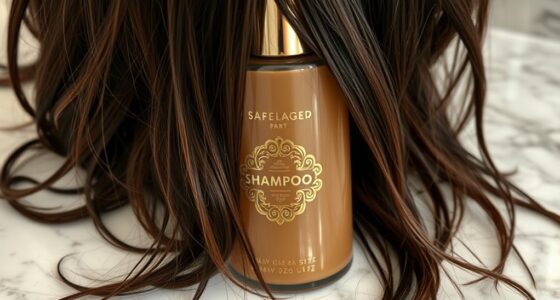Finding your hair’s perfect balance between protein and moisture is key to healthy, vibrant hair. If your hair feels dry, brittle, or breaks easily, it likely needs more protein to strengthen its structure. If it’s limp, limp, or overly soft, it probably needs extra moisture to restore shine and elasticity. Paying attention to how your hair responds and adjusting your routine accordingly will help you achieve the best health—there’s more to uncover for your ideal hair care.
Key Takeaways
- Assess your hair’s condition: dry and brittle indicates a need for more protein; limp and mushy suggests excessive moisture.
- Incorporate protein treatments to strengthen hair after damage, but avoid overdoing to prevent stiffness.
- Use moisturizing products to hydrate and restore elasticity, preventing dryness and breakage.
- Balance treatments based on hair signals, alternating protein and moisture care for optimal health.
- Regularly listen to your hair’s response and adjust your routine to maintain the ideal protein-moisture balance.

Understanding the balance between protein and moisture is essential for healthy hair. Your hair thrives when it gets just the right amount of both, but too much of either can lead to problems. When your hair lacks moisture, it becomes dry, brittle, and prone to breakage. Conversely, if it’s overloaded with moisture without enough protein, it can become soft, limp, and weak because it doesn’t have the necessary strength to hold its shape. Finding that sweet spot means paying close attention to what your hair needs and adjusting your routine accordingly. Incorporating hair porosity into your assessment can help determine whether your hair absorbs moisture quickly or resists it, guiding your treatment choices more effectively.
Balancing protein and moisture is key to healthy, resilient hair.
Protein provides your hair with strength and structure. It’s made up of amino acids that help rebuild and reinforce the hair shaft, especially after damage from styling, coloring, or environmental stressors. When your hair feels weak or shows signs of breakage, it’s often a sign that it needs a protein treatment. Incorporating protein-rich products into your routine can help restore resilience and improve overall health. But be cautious—overdoing it can make your hair feel stiff or straw-like, which indicates that your strands have become too rigid and are lacking flexibility.
Moisture, on the other hand, keeps your hair soft, smooth, and manageable. It restores elasticity and prevents dryness that can lead to split ends and breakage. If your hair feels rough, tangled, or looks dull, it’s a clear sign that it’s crying out for hydration. Using moisturizing conditioners, deep treatments, and water-based leave-ins helps replenish what’s lost and keeps your hair flexible and shiny. However, too much moisture without enough protein can cause your hair to feel heavy, mushy, or overly limp because it doesn’t have the internal support to maintain its shape and resilience.
The key to maintaining healthy hair is balancing these two elements. You want to add enough protein to strengthen your strands and enough moisture to keep them hydrated and pliable. If you notice your hair becoming dry or brittle, incorporate a protein treatment. If it feels soft but looks dull or limp, focus on moisturizing products. It’s a delicate dance—listening to your hair’s signals and adjusting your routine accordingly. Regularly alternating between protein and moisture treatments based on how your hair feels is a practical way to maintain this balance. Remember, every hair type is different, so what works for someone else might not be perfect for you. Paying attention to your hair’s response and making small adjustments will help you discover the ideal balance for your unique hair needs.
Frequently Asked Questions
How Do I Know if My Hair Needs More Protein or Moisture?
You can tell if your hair needs more protein if it feels weak, limp, or overly elastic, and shows signs of breakage. If your hair feels dry, brittle, or straw-like, it likely needs more moisture. To find the right balance, observe how your hair reacts to treatments. Regularly conditioning for moisture and incorporating protein treatments helps maintain healthy, resilient hair. Adjust based on how your hair responds over time.
Can Too Much Protein Damage My Hair?
Yes, too much protein can damage your hair. When your hair gets overloaded with protein, it can become stiff, brittle, and prone to breakage. This happens because excess protein can lead to a loss of flexibility, making your hair less elastic. To avoid damage, you should balance protein treatments with proper moisture, and pay attention to how your hair responds to different products. If your hair feels hard or stiff, cut back on protein.
Are There Natural Remedies for Balancing Protein and Moisture?
Yes, natural remedies can help balance protein and moisture in your hair. You might try deep conditioning with honey and olive oil, which deeply hydrate while strengthening. Aloe vera gel works wonders by soothing and moisturizing, preventing dryness. Incorporate bananas or avocados into your hair masks for added nourishment. These simple, natural solutions can restore harmony, revealing healthier, more resilient hair without the risk of overdoing it.
How Often Should I Use Protein Treatments?
You should use protein treatments every 4 to 6 weeks, depending on your hair’s needs. If your hair feels weak, brittle, or shows signs of breakage, increase treatments to every 3-4 weeks. For healthy, balanced hair, stick to the 6-week schedule. Always listen to your hair and adjust accordingly, ensuring you’re not over-treating, which can lead to stiffness and damage.
Does Hair Type Affect the Protein-Moisture Balance?
Did you know that 65% of hair damage is caused by improper moisture and protein balance? Your hair type definitely affects this balance; curly and coarse hair often needs more moisture, while fine or damaged hair benefits from additional protein. By understanding your hair’s unique needs, you can tailor your routine to keep your hair healthy, shiny, and resilient. Adjust your treatments accordingly for ideal results.
Conclusion
Finding the right balance between protein and moisture is like tuning a delicate instrument—you need just the right amount to keep your hair singing. Too much protein can make your hair feel stiff, while too much moisture can leave it limp. Listen to your hair’s signals and adjust accordingly. When balanced, your hair will feel resilient yet soft, like a well-played string—strong, flexible, and full of life.









